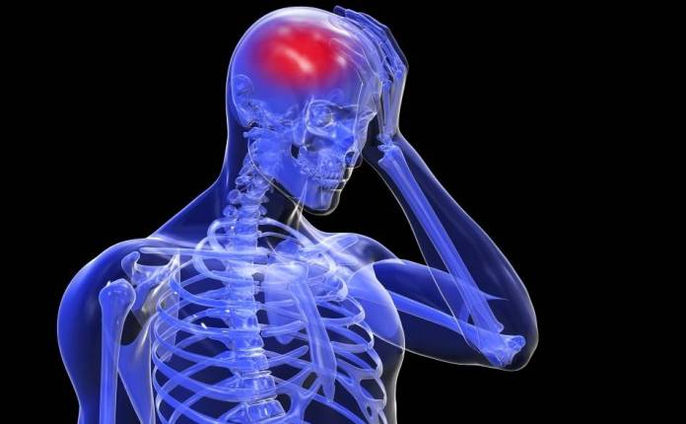Cervical osteochondrosis is a disease of the spine, which is characterized by interference of the intermediate disks.Pathology is characteristic for older people, but a person of all ages can meet it.Gears discomfort causes one of the main signs of this disease - severe pain.The patient must know what cervical osteochondrosis is dangerous and what problems he is faced.
The peculiarities of the disease
The cervix region is one of the most mobile parts of the body and meets regular loads.With the development of osteochondose, the vertebrae change, which leads to compression of numerous vessels and nerves.The main complexity of the pathology is that its characteristic dystrophic changes influence the roots of the nerve of the spine and the panes of the intervertebral disc space.For this reason, the brain remains lost without the necessary oxygen, blood supply.

In the risk zone there are mainly older people in whom the disease develops against the background of metabolic disorders, and changes in the structure of vertebrae and intervertebral discs are age -related.The reason for the development of such violations can also be:
- Salt deposit;
- Inadequate physical activity;
- improper nutrition;
- Injuries;
- Frequent hypothermia;
- Hormone problems;
- Obesity;
- Chronic diseases.
Osteochondrosis also provokes a long -term presence of the body in a position, the office worker and driver under the blow of.
Symptoms of osteochondrosis
In the early stages of the disease, the symptoms are almost invisible, fear can only cause slight pain in the neck.In the course of the pathology, the symptoms gradually increase.
Osteochondrosis of the cervical spine can be identified based on the following signs:
- Severe pain in the neck, neck, shoulders;
- regular migraines;
- Hand weakness;
- The mobility of the neck is limited;
- When turning the head, the vertebrae will grind;
- Hearing problems;
- A characteristic ringing appears in the ears;
- Discomfort in the throat.
In the initial phase, pain syndrome only manifests itself during movement when it is inclined or turning the neck.Over time, the pain occurs even when the position of the hands changes.
Possible complications
If no cervical osteochondrosis is treated, degenerative processes on the intervertebral discs lead to the loss of their main functions and a decrease in the density.The excessive mobility of the spine will gradually develop, muscles, joints and ligaments will suffer.The pressure on the nerve end and the spinal cord will only be tightened, which leads to an increase in symptoms and the development of new pathological phenomena.

Frequent migraines
You can calculate headaches for the most common consequences of osteochondrosis of the cervical spine.This is done because the vertebral artery is responsible for the delivery of oxygen and blood to the brain at this point.
When the hard disk thickness changes, the amortization functions are violated.Deformed vertebrae Press the artery, disturb the blood circulation and the "delivery" of the necessary oxygen.Muscle cramps develop.
Frequently accompanying symptoms follow after pain:
- Brawl;
- vomit;
- Strong pressure increase;
- Tingling in the shoulder blades;
- Weakness in the body.
In heavy attacks, it is desirable to relax as far as possible, it is better in a horizontal position.An unpleasant syndrome can remove pain relievers or cold compresses while the massage is useless.
Problems with seeing
Complications of cervical osteochondrosis often influence the visual organs: In this section of the spine, there are sleepy and vertebral arteries that are responsible for the visual central structure.The compression of nerve roots and blood vessels leads to hypoxia and leads to a reduction in eyesight.
Together with the syndrome of the vertebral artery, symptoms such as:
- Fog;
- darken in the eyes;
- the appearance of "flying" or colored spots;
- Crotch;
- excessive stress of the optic nerve;
- Dizziness;
- Brawl.

During the examination, a specialist can notice a narrowing of the arterial vessels of eye help, it is less common to swell the optic nerves.Glaucoma can also occur against the background of the disease, accompanied by increased inner pressure and pain.
Hearing problems
Due to the compression of the vertebral artery and nerve roots, hearing loss is possible by 20-30%.The neglected cervical osteochondrosis can lead to full deafness.To avoid this, you must contact a doctor in the first symptoms of the disease.
A slight decrease in hearing is reversible: In addition to medication treatment, which is prescribed by a doctor, the patient needs special exercises or massages of the ear shells.Listening to television or listening to music is better at a small volume to strain the hearing organs.
Hypotony or high blood pressure
Reduced or increased blood pressure are rather frequent consequences of cervical osteochondrosis.The greatest danger is high blood pressure that is characteristic:
- Operation of the pulse;
- increased sensitivity to temperatures;
- Sleep disorders;
- Nose bleeding;
- Dyspnea;
- Heart pain;
- Sweat.
The higher the blood pressure, the greater the load on the heart, which leads to quick wear.As a result, heart failure develops.In the case of high blood pressure, atherosclerosis develops faster, which is dangerous with a brain stroke.
Hypotenia is not a direct threat to life, but has a strong impact on quality.The body experiences oxygen hunger, which influences the patient's general borehole.Hypotony is characterized by violations of venous and arterial blood supply, and this means disorders in the sensitivity of the limbs.The possible complications include myocardial infarction.

Vegetes -Vascular dystonia
Vegetes -vascular dystonia is a general name of the syndrome that can influence several body systems and organs.Most of the pathology, cardiovascular system and peripheral nerves suffer from pathology.The patient has constant anxiety and sharp emotional differences.Frequent panic attacks are also possible and the heart rhythm becomes more common.
The symptoms of dystonia can be smeared or camouflaged as other diseases.In this case, the consequences of the osteochondrosis of the cervix region are not the most pleasant.Therefore, the stomach tract suffers frequently: nausea and vomiting, diarrhea, constipation and severe abdominal pain are possible.Diseases of the gallbladder or liver are possible.Patients often complain about tachycardia, pressure problems and heartache.
Intermediate vertebrae
With an intermediate shield hernia "protrude" fragments of the disc into the vertebral canal or fall out.The initial phase of this pathology is called a lead.The integrity of the intervertebral disc is not disturbed, but there is a slight lead of bones in the vertebral canal.At this stage, the pressure on the roots of the spinal cord is, so that the main symptom is the weak pain during movement.Pain syndrome is improved in the later stages.
The mobility of the vertebrae is gradually reduced.The muscle tension is improved, even if the patient seems to be in a relaxed state.You can also notice periodic weakness in the upper parts of the hands or in the wrists.The deafness of the hands appears and a tingling sensation often occurs near the thumb.
This is a dangerous osteochondrosis of half with hernia: it has a serious strain on the artery that runs next to the spine and is required for the correct blood supply to the brain.If an excessive pressure from the patient occurs, an ischemic stroke can be expected.
A large hernia is dangerous for the inflammation of the surrounding tapes - this is affected with cervical radiculitis.Only timely treatment can prevent complications.The patient has to listen carefully to his body and consult a doctor in the first symptoms.Suspected should cause:
- sharp nausea attacks without visible reasons;
- Darkling in the eyes when they move;
- Noise in the ears when turning the head;
- Pull the sensations in the neck with a long stay in a standing position.
The most serious complications are the risk of irreversible paralysis of one or both hands.The atrophy of the brain nerve leads to this, which is located in the cervix region.When the hernia begins to put pressure on the blood vessels, they gradually die, which leads to an innovation of a series of organs.
Vestibular barrel syndrome
Vestibular barrel syndrome is a disease in which the patient experiences a strong dizziness that goes hand in hand with the loss of orientation.
Attacks occur with a strong increase, turn and throws the head back.Characteristic of the state:
- Noise in the ears;
- Brawl;
- Visual impairment;
- The feeling that everything turns and hovers in front of his eyes.
The main reason for the pathology is the lack of blood supply, which included the dysfunction of the vestibular apparatus.The syndrome occurs more and more when osteochondrosis develops.
Wonderful minute syndrome
The started osteochondrosis is dangerous with neuro-vascular diseases of the neck and larynx.The syndrome is characterized by:
- Hoarseness;
- Difficulty swallowing;
- Constant feeling of a coma in the throat;
- Dryness and pain;
- Full loss of voice.
The syndrome suddenly occurs and is accompanied by dizziness.
Lieu syndrome bar
The second name of the pathology is the syndrome of the vertebral artery.The reason for its development is stenosis (narrowing) of the vertebral canal, in which the cramps of the vertebral artery and the compression of blood vessels and nerves occur.
Symptoms include:
- Hypertension;
- Brawl;
- Tachycardia;
- carve in the eyes;
- Noise in the ears;
- Loss of coordination of movements;
- Pulsating pain in the temples or in the hinterland region.
With a sharp movement or turning the neck, the patient can lose consciousness.

Hypotolamic syndrome
At the same time, the hypothalamus suffers from the syndrome - part of the brain that is responsible for metabolism, pressure, sleep, body temperature and emotional reactions of a person.Functional diseases can manifest themselves by improving or weakening the activity of the brain department.In the first case, the patient is inhibited in the second.
The symptoms often resemble neurasthenia, which manifests itself:
- Sleep disorders;
- Resentment;
- Irritability;
- High fatigue;
- Mood mood.
One person loses the opportunity to concentrate, there are problems with memorizing.Inappropriate outbreaks of anger are possible, appetite disappears, libido decreases.
It is better to prevent diseases than treating the behavior of osteochondrosis is quite difficult.If there are risk factors, you have to regularly carry out a number of simple physical exercises that increase the mobility of the vertebrae and eliminate the overload in the collar area.
The frequent appearance of a symptoms described is the obvious signal of the body about the problems that occur in it.At the same time, self -finishing is useless, and without consulting a specialist, it will not work.

















































